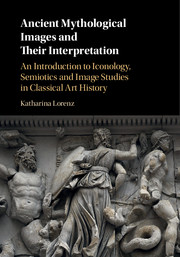 Ancient Mythological Images and their Interpretation
Ancient Mythological Images and their Interpretation 1 - Introducing iconology
from ICONOLOGY
Published online by Cambridge University Press: 05 August 2016
Summary
This ‘as if from an observation point’ obviously implies that Lucian himself was uncertain whether this figure was positioned further back, or was at the same time on higher ground. We need to recognise the logic of ancient bas-reliefs where figures further to the back look over those at the front, not because they are actually positioned above them but because they are meant to appear as if standing behind.
Lessing 1768/1769From its first, formative stages, iconology has been closely intertwined with the study of ancient art. This relationship distinguishes iconology from the other two methods discussed in this book, while underscoring the role of ancient art as a fundamental reference point for art-historical endeavours. In the 1932 article that was the first to sketch out the iconological enterprise, Erwin Panofsky borrowed the observation by Gotthold Ephraim Lessing cited above, on how the ancients approached art, to drive his argument directly at the core of the heuristic problems he intended iconology to solve.
Lessing had used Lucian's somewhat clumsy description of Zeuxis’ famed masterpiece of the fifth century BCE to pinpoint the fallacious nature of visual art, incapable of providing unequivocal information. Panofsky turned Lessing's ridicule of the medium the eighteenth-century scholar so deeply despised into evidence that no such thing as pure description of an artwork can exist. That Lucian of Samosata (120–80 CE), the learned polymath of the second century CE, had difficulty understanding the rules of perspective at play in a painting produced some centuries earlier – and during the classical period, a period seen as the epitome of artistic activity, and one understood to be accessible to all because of its ideal-typical character – was evidence enough for Panofsky to showcase that description is impossible unless based on an understanding of the workings of styles and artistic types at the time the artwork was created. And if description without such familiarity is impossible, the very process perceived as the unmediated part of any engagement with an artwork, then so too must be interpretation. In short, Panofsky held that one needs to be familiar with the artistic conventions of a period before one can attempt to interpret its artworks.
- Type
- Chapter
- Information
- Ancient Mythological Images and their InterpretationAn Introduction to Iconology, Semiotics and Image Studies in Classical Art History, pp. 19 - 36Publisher: Cambridge University PressPrint publication year: 2016


